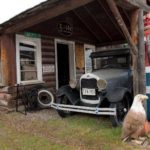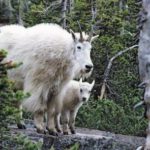The Mission Mountains
By Victor Block
Towering mountains overlook dense forests and broad plains that are home to a wealth of wildlife. That safari-like setting is reason enough to visit the northwestern corner of Montana. Add a choice of enticing towns, Indian reservations and vestiges of authentic cowboy culture and it’s no wonder that the area attracts a steady stream of visitors.
This is a region that clings proudly and stubbornly to touches of its frontier past. Rustic roadside signs advertise equally rustic establishments like the Bison Inn Café and Hungry Horse Saloon.
Communities and geographic places are named after former Native American chiefs (Charlo, Arlee), wildlife (Hungry Horse and Whitefish) and natural elements (West Glacier, Columbia Falls). Many residents of the region, as well as curious visitors, drown their thirst by quaffing a locally brewed beer named Moose Drool.
The area’s overall ambience may be encountered at hangouts like the Old Timer Café, a nondescript eatery in St. Ignatius. Its breakfast menu features the unfortunately named “cow patty,” which in reality is artery-clogging hash brown potatoes topped by ham, eggs and melted cheese, all buried beneath a pool of thick beef gravy.
Diners themselves provide an introduction to the region’s lifestyle. During my visit, two Native Americans wearing ornately beaded shirts shared a table with a cowboy, resplendent in 10-gallon hat, leather vest and chaps. Two bearded young men wore red jackets that sported the logo of their employer, “Robert Cattle Services – Bull Semen Collection.”
The down-home western flavor is evident everywhere. Ubiquitous boots, cowboy hats and country dancing are among touches that hint at a Marlboro Man machismo. Adding to the interest is that this western setting melds comfortably with a strong Indian culture.
The Flathead Reservation runs about 60 miles north to south, from Flathead Lake to just above Missoula. The Salish and Kootenai who live there are among 11 tribes that share reservations in Montana, making up about 9 percent of the state’s population. This strong influence adds to the feeling of having been transported back in America’s past.
Museums large and small re-create and retell the history of Native Americans who roamed the region and still make it their home. The People’s Center exhibits clothing, beadwork, cooking implements and other artifacts from the daily lives of the Salish, Pend d’Orielle and Kootenai tribes. At times, there are presentations of drumming, dance and other native traditions.
Other interesting collections are tucked away in restaurants, the back of stores and hidden recesses of hotels. For example, old photographs of Indians grace the lobby walls of the Kwa’TaqNuk Best Western Resort on Flathead Lake, and a diorama on the lower level depicts a teepee village.
Touches of Native American life and lore – pre-Columbian arrowheads, an eagle-handled dance stick, a bird feather fan – are among displays at the aptly named Miracle of America Museum. They share space with a jumble of more than 10,000 items that greet visitors to what has been called the “Smithsonian of the West.”
Among the eclectic collection of Americana are an old service station and 19th-century sod-roof log cabin. World War II tanks and jeeps share space with antique motorcycles, presidential election memorabilia and early dishwashing machines.
As much as any such collection, the majestic mountain setting of western Montana itself is a kind of outdoor museum. The town of Bigfork, is a community of resorts and galleries. The windows of art studios that line the quiet streets display traditional Western cowboy art along with more contemporary creations.
Kalispell got its name from the Native American words for “grassy land above the lake.” It’s home to close to three dozen artists.
Life of a different kind makes Glacier National Park a must-see part of any visit, and provides proof for the claim that Montana has more wildlife and fewer people than anywhere else in the 48 states. The refuge is home to an array of what a ranger referred to as “watchable wildlife,” and it didn’t take long to understand why.
I spotted a bear cub cavorting in a meadow, digging, scraping and rolling about. Two snow-white mountain goats appeared, preening as if posing for pictures. Several prong-horned antelope played a spirited game of tag, and a small herd of elk grazed in the distance.
Man-made attractions also vie for attention. For example, the town of St. Ignatius (population about 900) is the site of a mission which was founded by Jesuits in 1854 for the Flathead Indians. Visitors may view the mission church, which was built in 1891, and two small cabins that were the original homes of resident Jesuits and Providence nuns. Fifty-eight murals on the church walls and ceilings depict saints and scenes from the Old and New Testaments.
Unique touches like a small tepee perched on a side alter and hymns sung by a tribal chorus are reminders that this is Indian country. It’s a place where visitors have opportunities to immerse themselves in both history and present-day life, not to mention some of Mother Nature’s most magnificent handiwork.
For more information, call 800-847-4868 or log onto visitmt.com.
Photos/submitted















